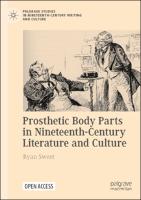Prosthetic Body Parts in Nineteenth-Century Literature and Culture
Editorial: Springer Nature
Licencia: Creative Commons (by)
Autor(es): Sweet, Ryan
This open access book investigates imaginaries of artificial limbs, eyes, hair, and teeth in British and American literary and cultural sources from the nineteenth and early twentieth century. Prosthetic Body Parts in Nineteenth-Century Literature and Culture shows how depictions of prostheses complicated the contemporary bodily status quo, which increasingly demanded an appearance of physical wholeness. Revealing how representations of the prostheticized body were inflected significantly by factors such as social class, gender, and age, Prosthetic Body Parts in Nineteenth-Century Literature and Culture argues that nineteenth-century prosthesis narratives, though presented in a predominantly ableist and sometimes disablist manner, challenged the dominance of physical completeness as they questioned the logic of prostheticization or presented non-normative subjects in threateningly powerful ways. Considering texts by authors including Charles Dickens, Edgar Allan Poe, and Arthur Conan Doyle alongside various cultural, medical, and commercial materials, this book provides an important reappraisal of historical attitudes to not only prostheses but also concepts of physical normalcy and difference.
[Bern: 2022]
Compartir:
Una vez que el usuario haya visto al menos un documento, este fragmento será visible.


